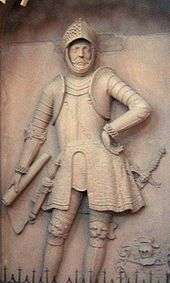Berthold II, Duke of Swabia

Berthold II (or Berchtold II) (c. 1050 – 12 April 1111) was the Duke of Swabia from 1092 to 1098.
Berthold was a son of Berthold II, Duke of Carinthia and initially supported Rudolf of Rheinfelden against King Henry IV. Both the Zähringer and Rheinfeldener were relieved of their titles and possessions by the king in 1077. Berthold I died in 1078 and Berthold inherited his claims, including a claim on the Duchy of Swabia. In 1079, Berthold married Agnes, Rudolf's daughter.
In the following years, he became a strong supporter of Berthold I, Duke of Swabia, against the king. He was at odds with the royal duke, Frederick of Büren, and the Bishops of Basel and Strasbourg. However, when the region quieted down in the late 1080s, Berthold is found as a witness to an exchange of land involving the bishop of Basel (1087).
Tensions rose again in 1090, when Berthold I von Rheinfelden died. Berthold of Zähringen asserted his claims to the Rheinfeldener inheritance in Burgundy, but not their titles, those went to Berthold's I younger brother Otto von Wetter(au)-Rheinfelden. He also placed a claim on the Duchy of Swabia. Supported by the Welfs and the Papacy, he was elected duke in opposition to Frederick in 1092. In that same year, he was chosen as Duke of Carinthia and Margrave of Verona (like his father) by those who opposed Duke Henry V. Berthold, also like his father, never held any real power in Carinthia.
In 1093, Berthold and Welf IV signed a "peace oath" at Ulm. At first only valid in Swabia, it was soon extended to Bavaria and strengthened opposition to the emperor in southern Germany. Around 1098, Berthold and Frederick came to terms whereby Frederick kept Swabia, but Berthold was given the Reichsvogtei (or imperial estates, depending on the source) of Zürich and allowed to keep the ducal title. By this step, the relationship between the Zähringers and Henry IV improved. In 1105, Berthold was the closest ally of Henry's son Henry V, who rebelled against his father.
Berthold, beginning in 1090, extended his power into the Breisgau so that the Zähringer territory extracted itself from the influence of the Swabian duke. In 1091, he built the castle of Zähringen, as well as a protective castle for the nearby settlement of Freiburg in the Breisgau. Berthold was the first of the Zähringers to hold the title "Duke of Zähringen" (from 1100). He established his rule with the foundation of monasteries and other settlements in the Black Forest. His territory was small and he had little opportunity for expansion. His ducal title was described by Otto of Freising as one of the first "empty titles" in medieval Germany: a title signifying little in the way of governmental or territorial significance. His was not a political or military office nor a tribal or territorial command. Rather, his ducal title was a mere dignity and his estates family possessions.
In 1093, he founded the Benedictine monastery of Saint Peter, which became the family mausoleum. The monasteries he founded were usually reformed monasteries hostile to the emperor. With the displacement of the Counts of Hohenburg from the region of the Black Forest, Berthold successfully turned it into his centre of power.
By the end of his life, Berthold's estates amounted to a justification of his grandiose title. He was succeeded as duke by his eldest son Berthold III. His second son Conrad succeeded Berthold III after eleven years.
| Berthold II, Duke of Swabia Born: c. 1050 Died: 12 April 1111 | ||
| Preceded by Berthold I |
Duke of Swabia 1092–1098 |
Succeeded by Frederick I |